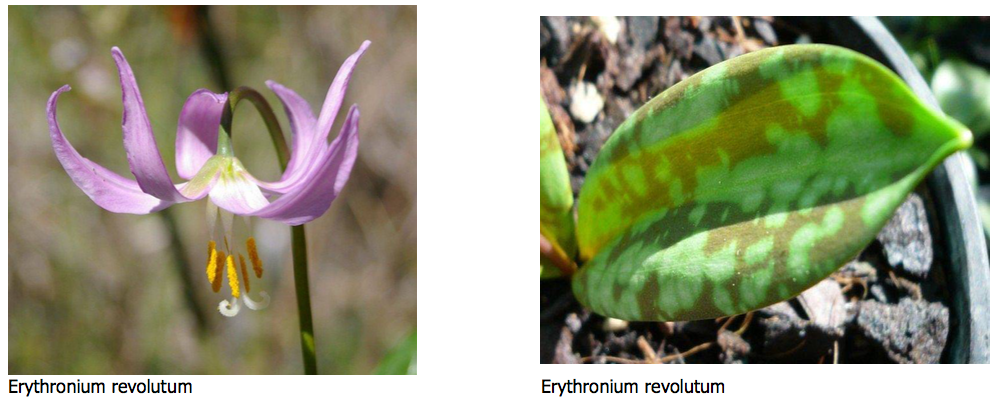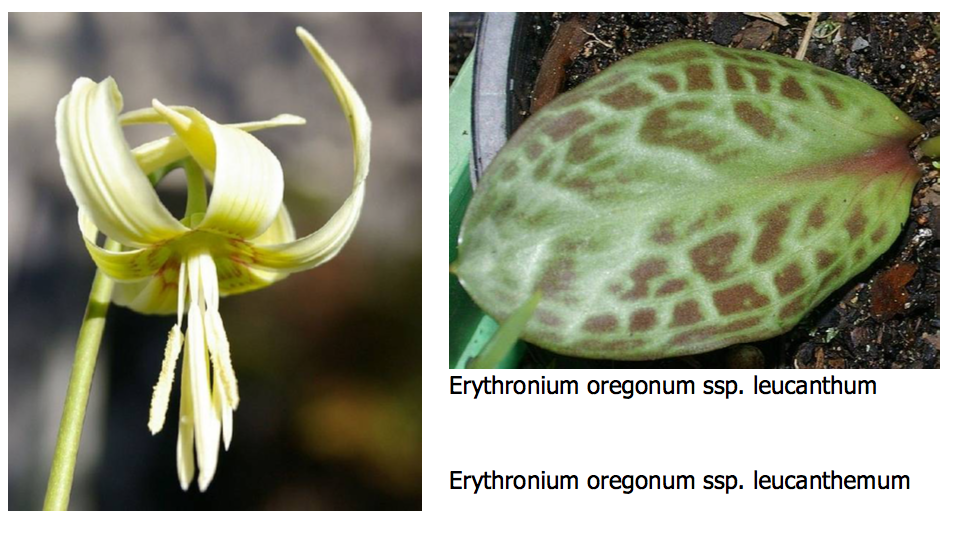ERYTHRONIUM
By Paul Tyerman

Also known as the ‘dogtooth violet’, ‘trout lily’, ‘fawn lily’ and ‘Adders Tongue’, erythronium is a genus that is found throughout Europe, China, Japan and North America, although most that we find available here in Australia are North American species. All have a distinctive recurved (i.e the petals fold back) cyclamen-like flower in spring. Colours range from white through to deep rose-pink, and almost all have some sort of central markings. Some species have plain green leaves, while others have spotted, silvered or heavily marbled foliage. If a shoot is going to flower it produces 2 leaves (with the flower/s emerging between them) and if it isn’t flowering then there is only one.
Personally, I think that the leaves alone are a good reason for growing this genus and leaves without markings are still lush and green, but the markings are quite spectacular.

Most of the more commonly available varieties are easy to grow and multiply here in Canberra. They’re all dappled shade lovers, liking perfect drainage in most cases, particularly while dormant. Some varieties will naturalise happily in the garden (some will even seed around), never needing to be lifted or requiring any particular care or attention.
I’d recommend an annual application of a slow release bulb food for those planted in the ground as they emerge in spring. This lasts them through their flowering and growth and increases the flower production dramatically. It is well worthwhile making the effort each year as the increase in flower is significant.

If you are wanting to lift and divide established clumps (or share bulbs with friends) then in some conditions you may have to go down a fair way as the bulbs tend to push downwards to where the soil conditions are cool and moist. In the garden they’re an ideal companion for other bulbs and perennials as they tend to be fairly early, before too many things get too big to shield them from view.
If they’re growing in pots I tend to repot each year as potting mixes can break down if left over too many years, drainage can be affected and this would result in deterioration of the bulbs.
I use a good quality potting mix and if necessary add some sand to increase drainage. I include some bulb food when I repot, plus Saturaid or some other wetting agent to help water penetration and drainage. The bulbs tend to migrate downwards in a pot, and if sitting on the ground they can sometimes escape out through the holes. A couple of years ago I had to move 3 little bulbs of one variety from one of my mulch paths, as they had grown down through the holes into the mulch below. There were still bulbs in the pot so I had no idea they’d escaped until I found Erythronium leaves coming up in the path after I’d moved the pots from that area. As they seemed so eager to be out of the pot I planted them into a nearby garden and, despite being in growth when I moved them, these bulbs did well as I kept the water up to them until they were established.
Last spring all 3 of them flowered and had offsets starting to appear. While this shows that they can be moved successfully when in growth I would not recommend it as the leaf stems are quite brittle and if broken off there will be no new leaves until the following year.
The following are some of my experiences with some of the species and cultivars:
E. tolumnense is probably the most commonly available variety. It has plain green leaves and up to 5 pure yellow flowers per stem. While individual flowers aren’t particularly large, an established clump makes up for them in numbers. This species can be put out in the garden where it will multiply and flower happily each and every year. Even without any fertiliser this species will flower each year, but usually only a few flower stems and only one or two flowers per stem. Application of a bulb food each year as the new shoots emerge results in many more stems and 4 or 5 flowers on each.
E. revolutum ‘Rose Beauty’ is a strong pink flowered variety with good leaf markings. It has only a single flower per stem but the combination of the dark markings on the leaves and the pink flowers is striking. This too has done well for me in the ground, multiplying well over time. It is quite a late emerger for me, so I tend to think I’ve lost it each year as most of the others are already up and flowering before this one pokes its noses out. This variety will set seed freely, but as with most Erythroniums it is quite promiscuous if there are others around. This means that seedlings may vary quite a bit from the parent.
E. californicum ‘White Beauty’ is another with leaf markings, but its flowers are white with a yellow eye. This variety can have 2 or 3 large flowers per stem and is another that will flower happily in the garden, also seeding freely.
E. oregonum ssp leucandrum is another with good leaves, including both dark and silver markings. The flowers are slightly cream rather than pure white, with delicate yellow and orange/red markings in the eye, and there are usually only one or two on each stem. I am currently experimenting with this species in the garden, but it has grown extremely well for many years in pots for me, multiplying well. I find that as this is not a pure white the flowers aren’t quite as noticeable, which is why I have kept it in a pot up until now.
E. multiscapoideum is white with a yellow eye. When in flower it looks like it is producing multiple flowering stems from each bulb, but it actually has a flower stem that branches below ground. It gives the appearance of having up to 4 or 5 flowers on separate stems.
E. dens canis is one of the non-North American species, coming from Europe. It has gloriously marked leaves and good pink flowers, although there are now available named varieties with different colouration to the flowers. This species I have kept in pots as it seems to be a bit touchier for me than many of the others. I think it needs better drainage and is more prone to rotting if too damp while dormant. Pots allow me to monitor this a little more easily, and limit watering where needed.
This is only a minor selection of the Erythroniums that are available from the specialist bulb lists here in Australia, and then there are a host of them that aren’t available here in Australia. If I went into
details of all of those then this article would be pages long.
The best Australian source for Erythroniums I think would be Marcus Harvey at ‘Hill View Rare Plants’ in Tasmania. Then there are places like the ‘Bryan Tonkin’ nursery in Victoria that list a couple in their lists each year including the lovely ‘Rose Beauty’. Some of more common varieties can sometimes be found in the more mainstream catalogues so you should just keep an eye out. If you know anyone who grows erythronium, maybe you can negotiate a trade or purchase. Once you’ve started you’ll be hooked.


